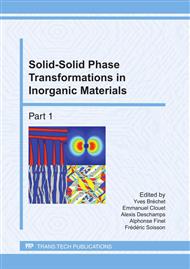p.402
p.408
p.414
p.420
p.426
p.432
p.437
p.443
p.449
Influence of Chromium Carbide Size on the Austenitization Kinetics of a Martensitic Stainless Steel Measured by Dilatometry
Abstract:
The use of martensitic stainless steels is commonly due to high mechanical properties requirements. To obtain these high values from the industrial material (whose microstructure consists in ferrite and M23C6 carbides), a suitable heat treatment, consisting in an austenitization of the steel at a temperature higher than A3 point, followed by a fast quenching, is necessary. For economic reasons, the shortest the heat treatment time, the better it will be. Therefore, one essential point, to reduce austenitization time, is to obtain a final product made of ferrite and carbides, with the lowest carbides size as possible: the lowest they will be, the shortest time the transformation ferrite + carbides --> austenite will take. The formation of these carbides occurs during the batch annealing of the steel, at low temperature. To study the influence of carbides size on the austenitization kinetics of a 1.4006 grade martensitic stainless steel, several batch annealings were made at different temperatures. Carbides sizes were measured by electronic microscopy and austenitization kinetics were measured by dilatometry. Small carbides size logically induces fastest austenitization kinetics. The austenization occurs in three stages: a fast one which corresponds to the dissolution of the smallest carbides leading to a homogeneous repartition of carbon, a chromium gradient into ferrite and thus an austenitization until reaching Cr-rich ferrite. The second one is limited by the diffusion of chromium, inducing a slower transformation. The apparent third stage is an artefact of the second one, as it corresponds to an expansion of the austenite due to the diffusion of carbide, and an apparent increase of the transformation kinetics.
Info:
Periodical:
Pages:
426-431
Citation:
Online since:
June 2011
Authors:
Price:
Сopyright:
© 2011 Trans Tech Publications Ltd. All Rights Reserved
Share:
Citation:


